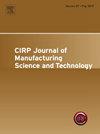栅极线弧加补篦板的应力分析及显微组织性能评价
IF 5.4
2区 工程技术
Q2 ENGINEERING, MANUFACTURING
CIRP Journal of Manufacturing Science and Technology
Pub Date : 2025-06-06
DOI:10.1016/j.cirpj.2025.05.016
引用次数: 0
摘要
针对高铬铸铁篦板电弧添加剂修复,提出了一种基于网格的路径规划方法。该方法采用直接投影技术在点云上生成表面网格,然后进行变姿态振荡填充。在修复过程中使用的低碳钢网格有效地抑制了HCCI中的裂纹扩展,防止了沉积金属的剥落。对比分析锯齿形、等高线偏移和栅格路径规划的应力分布,栅格路径分别使峰值应力和方差降低29.8%和9.6%。HCCI篦板体组织由初生奥氏体和马氏体组成。马氏体相变发生在共晶碳化物与初生奥氏体的交界面,板条马氏体包裹了共晶碳化物。初生碳化物和共晶碳化物均表现为六方密排结构,具有相似的晶体学特征。M7C3碳化物形成了坚固的耐磨框架,防止磨粒穿透基体,减少磨损表面的连续滑动。原生奥氏体提供了关键的结构支撑,防止了碳化物脱落,显著提高了材料的耐磨性。在750℃时,沉积金属的磨损率为2.02%,而在室温下,磨损率为1.46%。这两种磨损率都明显低于目前使用的篦板上沉积金属的3.71%的磨损率。HCCI的磨损表面呈现出大量的犁槽、微裂纹和碳化物剥落,这些剥落产生磨粒并加速磨损。主要的磨损机制是微切削和断裂诱导剥落的结合。本文章由计算机程序翻译,如有差异,请以英文原文为准。
Stress analysis and microstructure-property evaluation of grid-path wire arc additive repair grate plates
For the wire arc additive repair of high-chromium cast iron (HCCI) grate plates, a novel grid-based path planning method was proposed. The method employs the direct projection technique to generate surface meshes on the point cloud, followed by variable-attitude oscillatory filling. The low-carbon steel grid used during the repair effectively inhibits crack propagation in HCCI, preventing the spalling of the deposited metal. Comparative analysis of stress distributions among the zigzag, contour offset and grid path planning revealed that the grid path reduced peak stress and variance by 29.8 % and 9.6 %, respectively. The microstructure of the HCCI grate plate body consists of primary austenite and martensite. Martensitic transformation occurs at the interface between eutectic carbides and primary austenite, where lath martensite encapsulates the eutectic carbides. Both primary carbides and eutectic carbides exhibit a hexagonal close-packed structure with similar crystallographic characteristics. The M7C3 carbides formed a robust wear-resistant framework, preventing abrasive particles from penetrating the matrix and reducing continuous sliding on the wear surface. Primary austenite provided critical structural support, preventing carbide detachment and significantly improving the material’s wear resistance. At 750 °C, the wear rate of the deposited metal was measured at 2.02 %, while at room temperature, it was 1.46 %. Both rates were significantly lower than the 3.71 % wear rate of the deposited metal on the currently used grate plates. The wear surface of HCCI exhibits numerous plow grooves, microcracks, and carbide spalling, which generate abrasive particles and accelerate wear. The dominant wear mechanism is a combination of micro-cutting and fracture-induced spalling.
求助全文
通过发布文献求助,成功后即可免费获取论文全文。
去求助
来源期刊

CIRP Journal of Manufacturing Science and Technology
Engineering-Industrial and Manufacturing Engineering
CiteScore
9.10
自引率
6.20%
发文量
166
审稿时长
63 days
期刊介绍:
The CIRP Journal of Manufacturing Science and Technology (CIRP-JMST) publishes fundamental papers on manufacturing processes, production equipment and automation, product design, manufacturing systems and production organisations up to the level of the production networks, including all the related technical, human and economic factors. Preference is given to contributions describing research results whose feasibility has been demonstrated either in a laboratory or in the industrial praxis. Case studies and review papers on specific issues in manufacturing science and technology are equally encouraged.
 求助内容:
求助内容: 应助结果提醒方式:
应助结果提醒方式:


